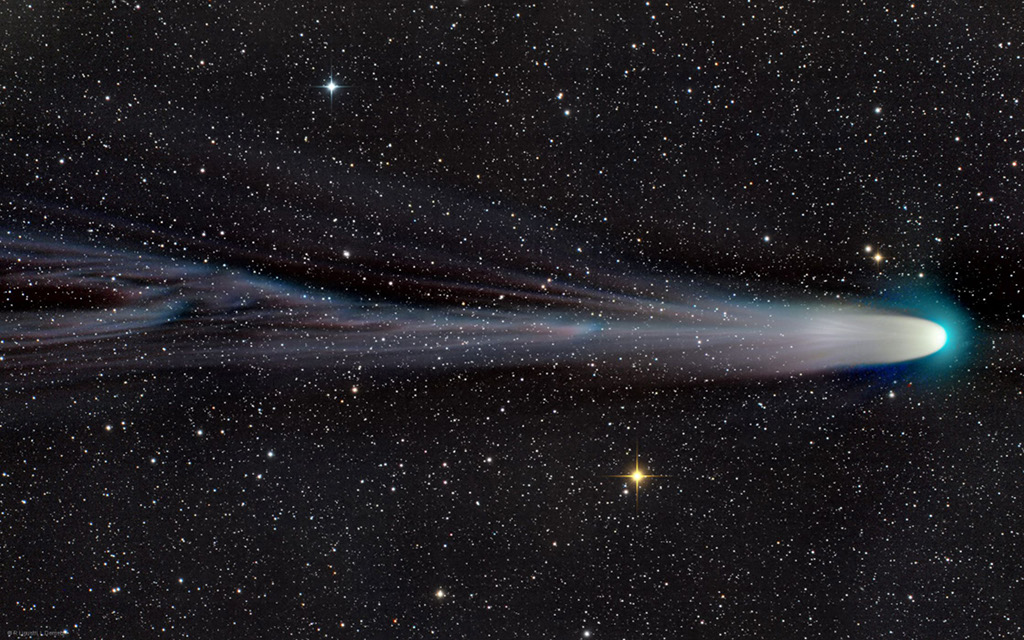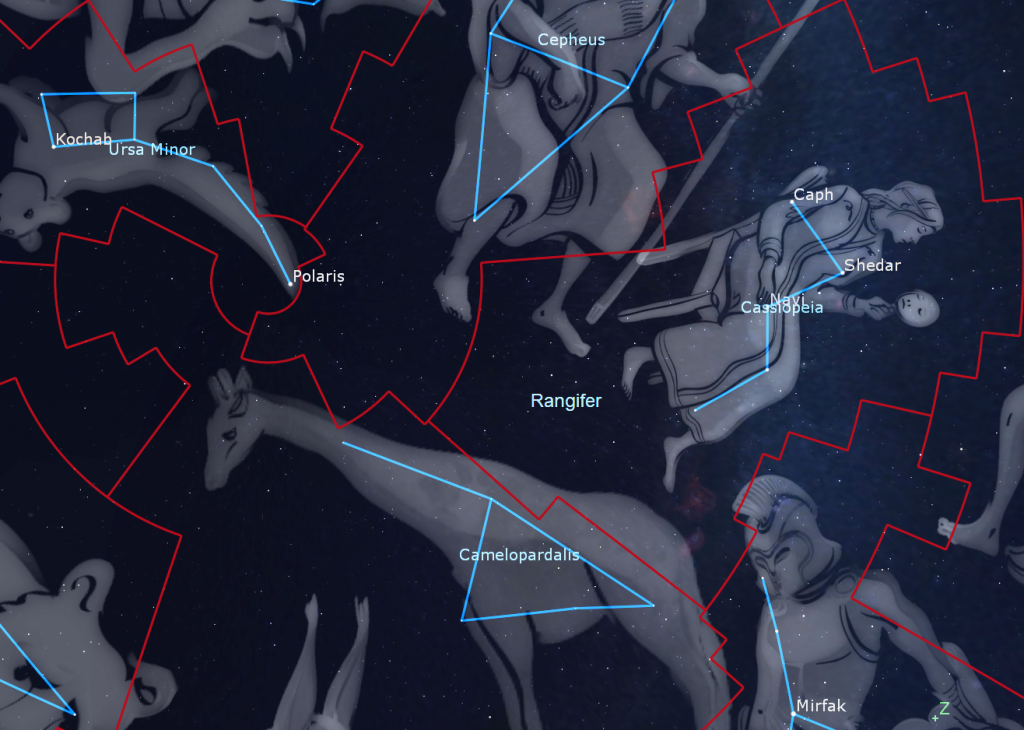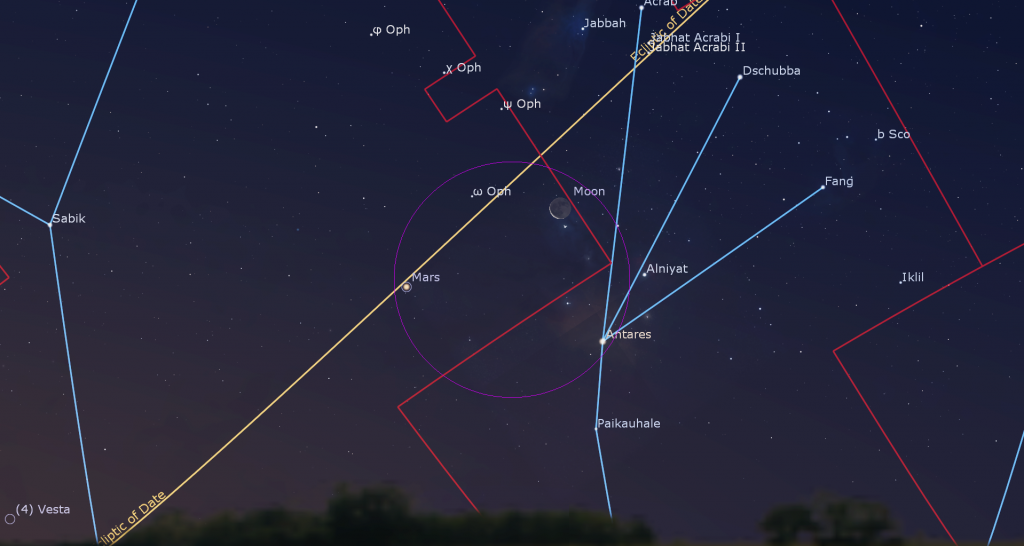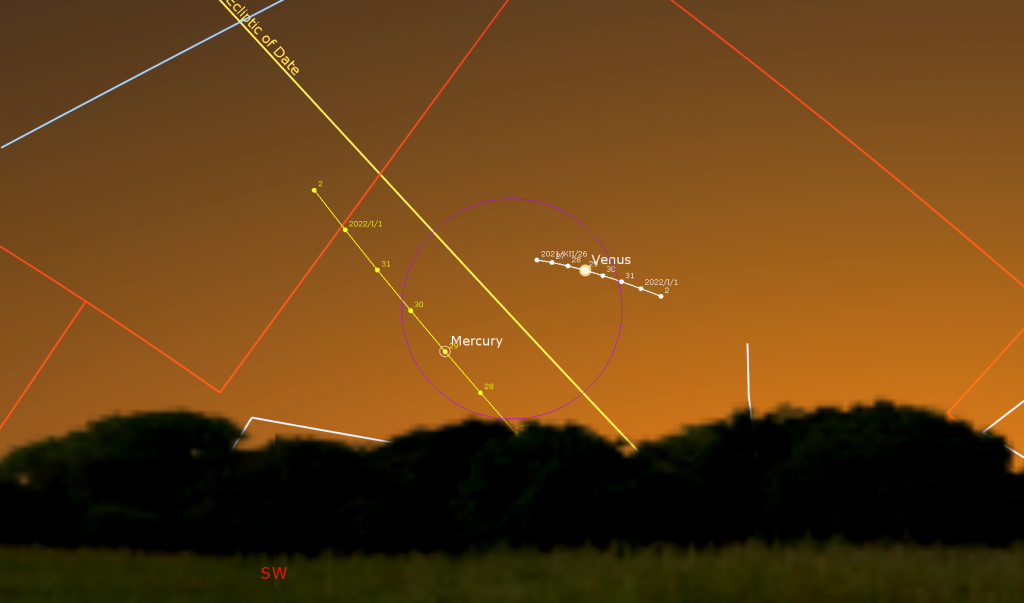Bright Planets Dance on Moonless Evenings, A Reindeer Rides the North Pole, and Morning Mars Meets its Rival!

This image of Comet C/2021 A1 (Leonard) was taken by Rolando Ligustri (CARA Project, CAST) and Lukas Demetz, while the comet was in outburst, under dark Namibian skies on December 21. The image spans three finger widths, left to right.NASA APOD image for December 25, 2021.
Happy New Year, Stargazers!
Here are your Astronomy Skylights for the week of December 26th, 2021 by Chris Vaughan. Feel free to pass this along to your friends and send me your comments, questions, and suggested topics. You can also follow me on Twitter as @astrogeoguy! Unless otherwise noted, all times are expressed in Eastern Time. To subscribe to these emails please click this MailChimp link.
If you’d like me to bring my Digital Starlab portable inflatable planetarium to your school or other daytime or evening event, or teach a session online, contact me through AstroGeo.ca, and we’ll tour the Universe, or the Earth’s interior, together! My terrific new book with John A. Read entitled 110 Things to See With a Telescope is a guide to viewing the deep sky objects in the Messier List – for both beginners and seasoned astronomers. DM me to order a signed copy!
A reindeer rides the North Celestial Pole. Mercury and Venus will dance in the west after sunset this week. Jupiter and Saturn will follow them down in early evening, leaving only ice giant planets observable in late evening. In morning, Mars will pass its rival Antares, with the old moon joining them at week’s end – just before it reaches new moon. Read on for your Skylights!
A Christmas Constellation – Rangifer (the Reindeer)!
According to astronomer Ian Ridpath, French astronomer Pierre-Charles Le Monnier (1715–99), in a star chart published in his 1743 book La Théorie des Comètes, created a faint, far-northern constellation close to the north celestial pole between Cepheus (the King) and Camelopardalis (the Giraffe). When illustrating the track of the Comet of 1742 through the north polar region of the sky, Le Monnier envisioned a reindeer on the comet’s course!

Labelled in various old charts as Rangifer and as Tarandus, he connected up some of the modest, magnitude 4 and 5 stars sitting between the “W” of Cassiopeia and Polaris. You have probably not heard of this star pattern because it is not one of the IAU’s official 88 constellations. Ian’s story about the reindeer is here. I think I’ll have to look for the critter on the next clear night!

Comet Leonard Update
Comet C/2021 A1 (Leonard) is fading in size and brightness now, for Earthlings. It will be traveling towards the sun until it reaches perihelion next Monday. As a result, the comet will experience more warming, which may result in outbursts of gas and dust that brighten it. A number of beautiful photos have been captured recently.
The views of the comet for Northern Hemisphere observers are poor now. This week, it will be in a bright sky right after sunset, just above the south-southwestern horizon, and shifting a small amount from right to left (or celestial southeastward) each night. For viewers in the tropics and the Southern Hemisphere, the comet will be well positioned about 1.5 fist diameters to the left of Saturn in a dark sky, near the border between the constellations of Microscopium (the Microscope) and Piscis Austrinus (the Southern Fish) – making it easy to see in binoculars and backyard telescopes.

The Moon
This is the week of the lunar month when our celestial sibling will be journeying toward the sun, and new moon, in the predawn sky worldwide. For the early part of the week, the moon will appear as the pale Ghost of Christmas Past in the morning daytime sky.
On Monday morning, early risers can see the almost half-illuminated moon shining in Virgo (the Maiden), very closely above its pretty, double star Porrima (or Gamma Virginis). The waning moon won’t depart the stars of Virgo until it slides into next-door Libra (the Scales) for Wednesday and Thursday morning.
Low in the southeastern sky on Friday morning, the slim crescent of the old moon will shine above and between the reddish dot of Mars and Scorpius’ brightest star, Antares. The trio, with Mars on the left (celestial east), will be less than 5 degrees apart, close enough to share the view in binoculars. You can observe them from the time they rise, shortly before 6 am local time, until sky brightens before sunrise. At about 18:30 Greenwich Mean Time on Friday morning, observers in parts of southern Australia, Tasmania, Antarctica, the South Georgia Islands, the southern tip of South America, and the Falkland Islands can see the moon cross in front of (or occult) Mars!

The moon will be out of sight on the coming weekend. On Sunday at 1:33 pm EST or 18:33 GMT, the moon will officially reach its new moon phase, while in Sagittarius (the Archer). It will then sit approximately 4.3 degrees south of the sun. While new, the moon is travelling between Earth and the sun. Since sunlight can only reach the far side of a new moon, and the moon is in the same region of the sky as the sun, our natural satellite becomes completely hidden from view for about a day. This new moon will occur less than a day after lunar perigee, resulting in large tides around the world.
The Planets
Four bright planets will be visible in the southwestern sky after sunset this week. The two faint ice giant planets Uranus and Neptune will be visible after dark, too. Only Mars, which is hanging out in the predawn east, will be missing.
Magnitude -0.71 Mercury will be climbing away from the sun this week. Meanwhile, 34 times brighter Venus will be slowly descending sunward each night. Tonight (Sunday) Venus will sit a palm’s width above (or 6° to the celestial southwest of) Mercury. As the sky begins to darken after sunset, put Venus at the top of your binoculars’ field of view and then look for Mercury at the bottom of the same field. If your binoculars have a small FOV, just pan them down a little. On Tuesday and Wednesday, the two planets will pass within a few fingers widths of one another, with Mercury to Venus’ lower left. From Friday onward, they’ll be too far apart to be binoculars-close. Mercury will be higher than Venus, too.

The best time to see Mercury at mid-northern latitudes will be around 5 pm local time. Viewed in a telescope, Mercury, situated on the far side of the sun from Earth, will exhibit a 70%-illuminated disk – like a rugby ball. Venus will show a razor-thin sliver because it will be positioned between us and the sun. Wait for the sun to completely disappear and then aim your telescope at Venus as soon as you can spot the planet in the sky. That way, the planet will be higher and shining through less distorting atmosphere – giving you a clearer view of it. A brighter sky will also allow Venus’ shape to be seen more readily. Next week will be our final chance to see Venus in evening until November, 2022!
The bright, white dot of Jupiter will shine more than three fist diameters to Venus’ upper left (or 34° to the celestial east). Once the sky darkens more, much fainter, creamy-coloured Saturn will appear midway between them. Those planets are being carried relentlessly sunward by Earth’s orbital motion. Once Jupiter becomes unobservable beside the sun in late January, we’ll have to wait until August to see a bright evening planet (Saturn)! Jupiter and Mars won’t return until autumn.
At this time, Saturn is parked in Capricornus (the Sea-Goat) and Jupiter is next-door in Aquarius (the Water-Bearer). Saturn will set in the west at about 7:30 pm local time, with Jupiter 90 minutes behind that – so observe each planet as early as you can spot it, while it’s higher. Remember to take long, lingering looks through the eyepiece – so that you can catch moments of perfect atmospheric clarity.
Binoculars and small telescopes will show you the Jupiter’s four large Galilean moons named Io, Europa, Ganymede, and Callisto. Since Jupiter’s axial tilt is a miniscule 3°, those moons always look like beads strung on a line that passes through the planet, and parallel to Jupiter’s dark equatorial belts. That line of moons, and the belts, tilt as Jupiter crosses the sky. The moons’ arrangement varies from night to night. Io, for example, orbits Jupiter once every 42 hours. From one night to the next night, 24 hours has elapsed on Earth – time for Io to complete half an orbit and shift from one side of Jupiter to the other. The other Galilean moons move less rapidly, taking between 3.5 and 16.7 days to orbit Jupiter.
For observers in the Eastern Time Zone with good telescopes, the Great Red Spot (or GRS) will be visible while it crosses Jupiter after dusk on Monday and Saturday, and in mid-evening on Wednesday. From time to time, the small, round, black shadows cast by Jupiter’s Galilean moons become visible in amateur telescopes when they cross (or transit) the planet’s disk. On Thursday evening, December 30, observers in the Americas with telescopes can watch the small round shadow of Jupiter’s moon Io cross the planet with the Great Red Spot for 2 hours starting at 3 pm EST (or 20:00 GMT).

Distant, dim Neptune is in the evening sky, too – near the border between Aquarius (the Water-Bearer) and western Pisces (the Fishes). The magnitude 7.9 planet is also two fist diameters to the upper left (or 20° to the celestial east) of Jupiter. Neptune continues the string of planets that starts at Mercury and Venus – defining the plane of our solar system across the sky. Try to view it in early evening, while it sits higher in the sky.
Over in the southeastern sky, Uranus is shining at magnitude 5.7. Look for the planet’s small, blue-green dot moving slowly retrograde westwards in southern Aries (the Ram), a fist’s width below (or 11.5 degrees southeast of) that constellation’s brightest stars, Hamal and Sheratan. Or use binoculars to locate Uranus using the nearby star Mu Ceti. Uranus is also about 1.6 fist diameters to the upper right (or 16 degrees to the celestial west-southwest) of the Pleiades star cluster (more about that below). This week Uranus will be observable all night long – especially around 8 pm local time, when it will have climbed more than halfway up the southeastern sky. Two fist diameters farther east you’ll find the dwarf planet named (1) Ceres.
This week Mars will continue its year-long journey to a bright showing at opposition in December, 2022. You might spot the magnitude 1.5 planet shining very low in the southeastern sky, near its rival Mars, just after it rises before 6 am local time, especially if you live at a tropical latitude. Your odds of successfully spotting Mars will improve on each subsequent morning. Take care to turn binoculars and telescopes away from the eastern horizon well before the sun rises.
A Christmas Star and Appreciating the Pleiades
If you missed last week’s information about planetary conjunctions with Venus inspiring the “Christmas Star”, and seeing the beautiful open star cluster known as The Pleiades and the Seven Sisters, I posted it here.
Public Astro-Themed Events
Every Monday evening, York University’s Allan I. Carswell Observatory runs an online star party – broadcasting views from four telescopes/cameras, answering viewer questions, and taking requests! Details are here. Their in-person Wednesday night viewing has been converted to online via the observatory YouTube channel.
My free, family-friendly Insider’s Guide to the Galaxy webcasts with Jenna Hinds and Samantha Jewett of RASC National returns on Tuesday, January 18 at 3:30 pm EST. You can find more details and the schedule of future sessions here.
Don’t forget to take advantage of the astronomy-themed YouTube videos posted by RASC Toronto Centre and RASC Canada.
Keep looking up, and enjoy the sky when you do. I love questions and requests. Send me some!